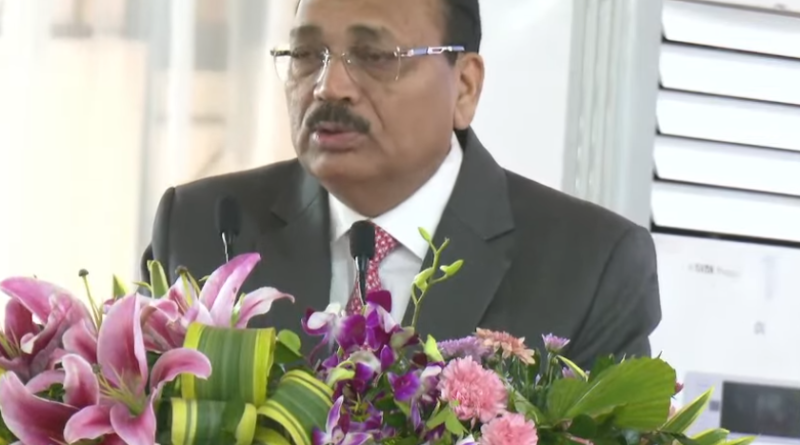Justice Surya Kant Draws Parallel with Hospitals, Says High Courts Must Deliver Emergency-Level Justice
(By Syed Ali Taher Abedi)
Ranchi, Friday — Drawing a powerful parallel between the justice system and medical emergency care, Supreme Court Judge Justice Surya Kant on Friday said that High Courts must evolve into institutions capable of responding to injustice with the same immediacy, precision and coordination as a hospital’s emergency ward. He was speaking at the silver jubilee celebrations of the Jharkhand High Court in Ranchi.
Justice Surya Kant stressed that just as emergency departments cannot afford delays when lives hang in the balance, High Courts too must be equipped to deliver swift and effective relief the moment a crisis arises. “The High Courts must act with speed and clarity. Justice delayed, especially in critical moments, risks becoming justice denied,” he said.
“I believe that High Courts must begin to envision their institutional growth much like a modern hospital designs its emergency services—with structures that are equipped to respond swiftly,
decisively, and with precision at the very moment a crisis arises. In the same way that an emergency ward cannot afford delay, our Courts too must aspire to that level of preparedness, efficiency, and coordinated response. This means strengthening technological capacity, streamlining
procedures, building specialised expertise, and ensuring that judicial processes can adapt instantly to emerging situations. Only with such foresight can the Judiciary continue to deliver timely and effective remedies, rising to every challenge with the speed and clarity that a constitutional democracy demands. These are not mere administrative ideas; they are the next step in the evolution of access to justice
Emphasising the transformative role of the judiciary, he described High Courts as powerful engines of social reform. Their unique constitutional position, wide jurisdiction and proximity to the people, he said, place them at the centre of shaping legal development and driving social change. “
“High Courts are where the highest principles of justice meet the lived realities of ordinary citizens,” he observed.
Reflecting on his early years as a judge, Justice Surya Kant recalled a cross-border custody dispute involving two young children. What affected him most, he said, was not the legal complexity of the matter but the silent distress of the children caught between two jurisdictions. “It was then I realised that judging is not merely the application of doctrine. It is a profound responsibility to ensure the protection of law reaches those most vulnerable,” he said.
Justice Surya Kant explained that India’s justice system rests on three complementary pillars: the lower courts that address everyday grievances and sustain public trust; the Supreme Court, which guards constitutional boundaries; and in between, the High Courts, which serve as a vital bridge between citizens and the Constitution.
“This constitutional architecture is carefully designed. The three-tiered structure of our Justice Delivery System accomplishes its goals in complementary ways. District Courts handle the daily concerns of the
people at the grassroots, fostering faith in justice across communities. The Supreme Court, at the national summit, is our final sentinel, ensuring that no constitutional breach passes unchecked. And, between these two poles lies the bridge between the citizen and the Constitution—the High Courts—which form the backbone of justice and
shape the daily experience of constitutional ideals for millions.”
He highlighted that the High Courts’ powers under Article 226 are even broader than the Supreme Court’s jurisdiction under Article 32, as they extend not only to fundamental rights but also to all other legal rights. “This authority makes the High Courts the backbone of constitutional justice,” he said, noting that their judgments reflect local realities, cultural contexts and regional challenges, giving justice a “human touch and a local heartbeat.”
Turning to the host institution, Justice Surya Kant praised the Jharkhand High Court’s 25-year journey as one marked by resilience, innovation and a steadfast commitment to constitutional values. He highlighted notable decisions protecting tribal rights, workers’ dignity, environmental resources, and principles of intergenerational equity in mineral extraction. “From its earliest years, the Court treated every challenge as an opportunity to strengthen the rule of law,” he remarked.
He also commended the High Court’s proactive adoption of technology, calling it essential for modern judicial administration. Investments in e-filing, real-time case tracking, a searchable digital database and accessibility tools for visually challenged litigants, he said, have made the court’s processes more transparent, efficient and citizen-friendly. “Technology is no longer optional — it is a core component of delivering justice,” he noted.
Justice Surya Kant further acknowledged the humanitarian work of High Courts through the State Legal Services Authority, which designs legal literacy and access-to-justice programmes for marginalised communities. Such initiatives, he said, ensure that justice reaches the poorest and most vulnerable.
Looking ahead, he urged High Courts to prepare for emerging challenges that will shape the coming decades — including rapid technological disruption, climate pressures, demographic shifts, cybercrimes, digital evidence, and resource-based conflicts. Meeting these complexities, he said, will require new skills, institutional agility and a future-ready judicial mindset.



